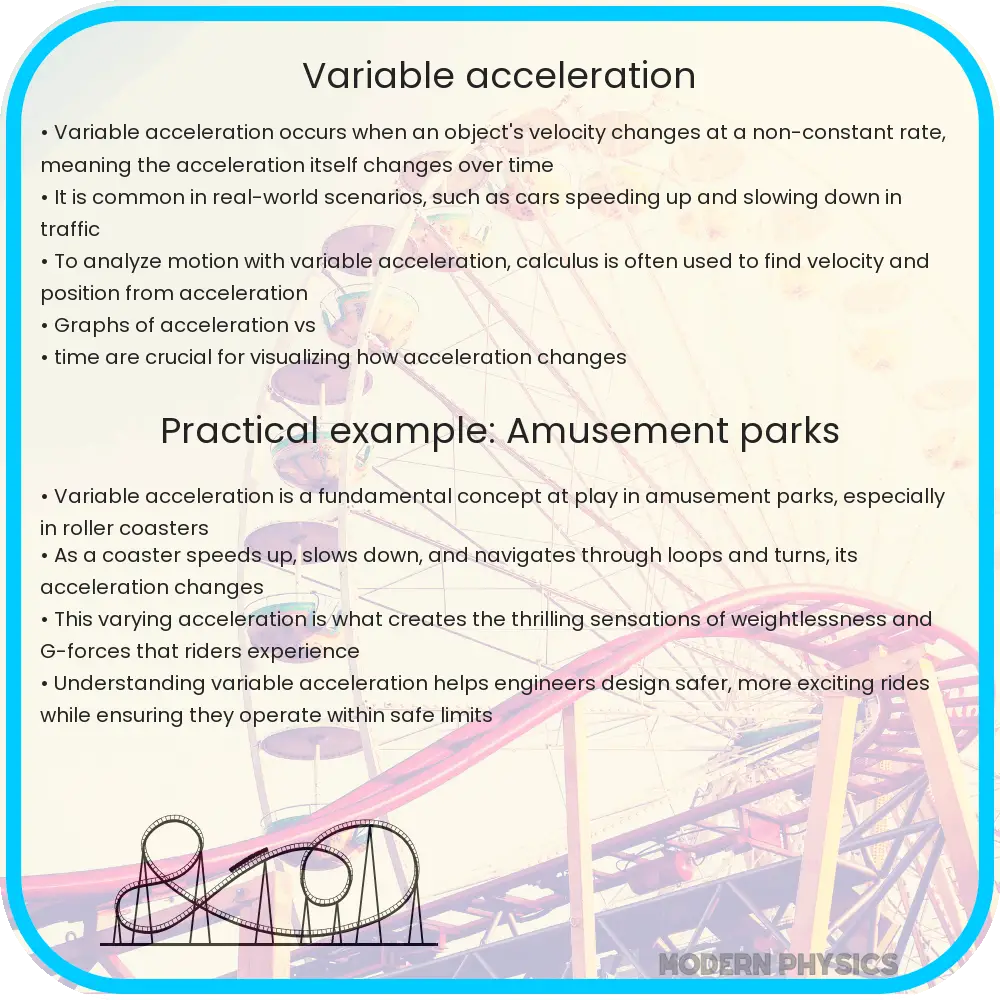Explore the complexities of variable acceleration in motion, velocity, and kinematics, with practical examples and mathematical insights.

Understanding Variable Acceleration: Motion, Velocity, and Kinematics
Variable acceleration is a fundamental concept in the study of motion, velocity, and kinematics in physics. It refers to the rate at which an object changes its velocity over time, and unlike constant acceleration, it varies at different moments during the motion of the object. This article aims to provide a comprehensive understanding of variable acceleration, its implications in motion, and how it is expressed and calculated in kinematics.
Defining Variable Acceleration
Acceleration is defined as the rate of change of velocity of an object with respect to time. When an object experiences variable acceleration, its velocity changes at a non-uniform rate. This can be due to various factors such as gravitational forces, frictional forces, or applied forces. Variable acceleration is a vector quantity, meaning it has both magnitude and direction.
Motion Under Variable Acceleration
The motion of an object under variable acceleration is more complex than under constant acceleration. The distance traveled and the velocity at any given time can vary significantly. To analyze such motion, calculus is often used, particularly differentiation and integration, to derive equations that describe the velocity and position of the object over time.
Mathematical Representation
In kinematics, variable acceleration is often expressed as a function of time (a(t)). The velocity (v(t)) and displacement (s(t)) of an object can then be determined by integrating the acceleration function. The basic formula for acceleration is:
a(t) = dv/dt
where dv/dt represents the derivative of velocity with respect to time. Similarly, the velocity function can be obtained by integrating the acceleration function:
v(t) = ∫ a(t) dt
And displacement can be calculated by integrating the velocity function:
s(t) = ∫ v(t) dt
Practical Examples
Variable acceleration is a common occurrence in everyday life. For instance, a car speeding up and slowing down in traffic, a roller coaster moving through its varied path, and the motion of planets in their elliptical orbits around the sun all exhibit variable acceleration. Understanding these principles is essential not only for physics but also for engineering, astronomy, and various applied sciences.
Calculating Variable Acceleration
To calculate variable acceleration, one must often rely on specific information about the forces acting on an object or empirical data obtained through observation or experimentation. For example, in the case of a car, the acceleration can change due to varying engine power or resistance forces like air drag and friction. The acceleration at any given moment can be calculated using Newton’s second law of motion:
F = ma
Where F is the net force acting on the object, m is the mass of the object, and a is the acceleration. By rearranging this formula, the acceleration can be found as:
a = F/m
Graphical Representation of Variable Acceleration
Graphically, variable acceleration can be represented using velocity-time and displacement-time graphs. In a velocity-time graph, the slope at any point gives the acceleration at that instant. A curved line in this graph indicates that the acceleration is changing over time. Similarly, in a displacement-time graph, the curvature of the graph indicates variable acceleration.
Applications in Real-World Scenarios
Understanding variable acceleration is crucial in various fields. In automotive engineering, it helps in designing vehicles that can safely navigate different speeds and terrains. In sports science, it aids in analyzing the performance of athletes, especially in sports involving rapid changes in speed and direction. In space exploration, it is fundamental in planning the trajectories of spacecraft, considering the varying gravitational forces exerted by celestial bodies.
Conclusion
Variable acceleration is a key concept in understanding motion and kinematics. It differs from constant acceleration as it involves changes in velocity that are not uniform over time. This concept is crucial in analyzing real-world scenarios where forces acting on objects are not constant. Through mathematical formulas, graphical representation, and practical examples, we gain a deeper understanding of how objects move in our world. Whether it’s for academic purposes, in engineering designs, or in understanding natural phenomena, grasping the intricacies of variable acceleration is essential for anyone delving into the realm of physics and beyond.
